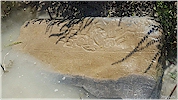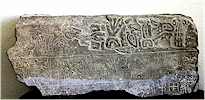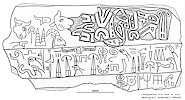Türkçe
Türkmenkarahöyük - Hartapu Stele
The stele was discovered in 2019 during a survey by KRASP (Konya Regional Archeological Survey Project) when a local farmer drove the team's attention to the inscribed stone block. It was found lying half submerged inside an irrigation channel about 600 meters to the east of the Türkmenkarahöyük mound in the Çumra district of Konya province. The three-line Luwian inscription commemorates a victory of Great King Hartapu against the Land of Muska. The paleographic features of the inscription point to a date in the 8th century BCE. The Muska mentioned here is probably a reference to the Phrygian state known to have existed during that time in west-central Anatolia and referred to in Assyrian sources as Muki. Great King Hartapu is also attested in Kızıldağ, Karadağ, and Burunkaya monuments. The stele is in Konya Museum.
In 2021, during research conducted at the site, a round topped stele with a flattened front face that bears a single Hieroglyphic Luwian character (LUNA="moon") was discovered.
Click on the pictures for larger images.



